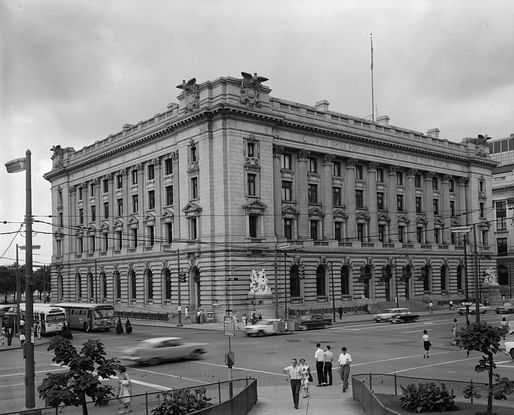

In a statement posted the American Institute of Architects (AIA) website, the organization explains that a group of former AIA presidents have written a letter directly to President Donald Trump denouncing the "Making Federal Buildings Beautiful Again" executive order.
The letter comes as 2020 AIA President Jane Frederick, AIA CEO and Executive Vice President Robert Ivy, and 2021 AIA President-Elect Peter Exley all denounced the initiative at the Grassroots Leadership Conference held in New Orleans las week. At least 34 current and past AIA presidents signed the letter, including Raj Barr-Kumar, William J. Bates, Helene Combs Dreiling, Carl Elefante, Carroll J. Lawler, Susan A. Maxman, Marshall E. Purnell, Elizabeth Chu Richter, Katerhine L. Schwennsen, W. Cecil Steward, and Chester A. Windom, among others. For the full text of the letter, see here.
The controversial proposal would impose a federally mandated neoclassical style on all federal building projects with budgets higher than $50 million. The proposed executive order has been widely denounced by critics, professional groups, and individual architects and practices since plans for the executive order were first announced earlier this month.
The AIA reports that over 11,000 of the organization's 95,000 members have written to the White House asking for the order to be disregarded.
The full text of the letter follows:
We, the undersigned former Presidents of the American Institute of Architects, write to ask you to reconsider your proposed Executive Order establishing a mandate for federal courthouses and other federal projects. The draft order directs these projects to be executed in neoclassic style of design. We strongly feel that the stipulation of a one- size-fits-all approach to building design would ultimately result in sub- optimal buildings.
This is true whether the design “style” is modern or classical. It is essential to embrace regional circumstances and culture. This investment should ultimately contribute to the evolving legacy of American life and liberty.
The investment of federal funds into public buildings demands an appropriate return on investment to the American people – the taxpayers. That return is not guaranteed by stipulating a singular design style; it is achieved by engaging in a rigorous process that engages the most qualified and experienced design and construction professionals. In fact, it is well-known that neoclassical design often equates to higher construction costs and extended time schedules for project completion.
For every great American architect with a legacy of classically designed buildings (like Jefferson, Latrobe, Walter and McKim) there is a counterpart with an equivalent legacy of modernism (like Sullivan, Wright, Saarinen and Kahn). Both groups contributed enormously to American cultural evolution. Please do not stifle that evolution by executing this Order.
Architecture is not only a visual art, it is a public art, which embraces public input and dialogue. Every community is free to establish its own cultural expressions through the arts. In multicultural communities, the diversity of these expressions is key to the perception of urban vitality and creativity in America (Example: the GSA Architecture Excellence Program where local context and local participation are essential to design parameters).
Collectively, we implore you to encourage (not discourage) the engagement of American communities to continue to search for the freedom of expression. A mandate for neoclassicism, as proposed, will slow the national and community pace of progress and innovation.
Despite this administration’s intended reduction of burdensome federal regulations and unnecessary expenses, this proposed order will result in the exact opposite outcome for municipalities, businesses, architects, engineers, construction managers, artists, and contractors.
Sincerely,
Ronald A. Altoon, FAIA, Encino, CA; Raj Barr-Kumar, FAIA, RIBA, Washington, DC; William J. Bates, FAIA, Pittsburgh, PA; John A. Busby Jr., FAIA, Atlanta, GA; L. William Chapin II, FAIA, Daytona Beach, FL; Gordon H. Chong, FAIA, Lafayette, CA; Sylvester Damianos, FAIA, Verona, PA; Russell A. Davidson, FAIA, Mount Kisco, NY; Helene Combs Dreiling, FAIA, Massanutten, VA; Carl Elefante, FAIA, Washington, DC; Donald J. Hackl, FAIA, Wilmette, IL; Eugene C. Hopkins, FAIA, Ann Arbor, MI; Mickey Jacob, FAIA, Tampa, FL; Carroll J. Lawler, FAIA, Hartford, CT; Marvin J. Malecha, FAIA, San Diego, CA; Clark D. Manus, FAIA, San Francisco, CA; Susan A. Maxman, FAIA, Philadelphia, PA; John M. McGinty, FAIA, Houston, TX; George H. Miller, FAIA, New York, NY; Ted P. Pappas, FAIA, Jacksonville, FL; Thompson E. Penney, FAIA, Charleston, SC; Raymond G. Post Jr., FAIA, Baton Rouge, LA; Jeffery Potter, FAIA, Hon. RAIA, Dallas, TX; Marshall E. Purnell, FAIA, Raleigh, NC; Elizabeth Chu Richter, FAIA, Corpus Christi, TX; Katherine L. Schwennsen, FAIA, Clemson, SC; Charles E. Schwing, FAIA, Baton Rouge, LA; Ronald L. Skaggs, FAIA, FACHA, Plano, TX; Michael J. Stanton, FAIA, San Francisco, CA; Douglas L. Steidl, FAIA, Peninsula, OH; W. Cecil Steward, FAIA, Lincoln, NE; RK Stewart, FAIA, Salt Lake City, UT; R. Randall Vosbeck, FAIA, Highlands Ranch, CO; and Chester A. Widom, FAIA, Los Angeles, CA.
Learn more about former AIA presidents on AIA’s website.
No Comments
Block this user
Are you sure you want to block this user and hide all related comments throughout the site?
Archinect
This is your first comment on Archinect. Your comment will be visible once approved.